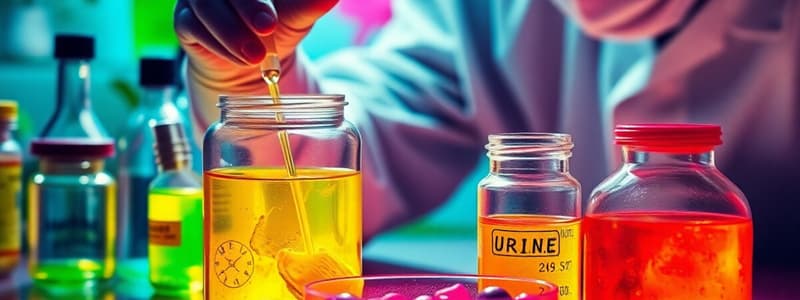Podcast
Questions and Answers
Which urine preservative is suitable for maintaining glucose and sediments effectively?
Which urine preservative is suitable for maintaining glucose and sediments effectively?
- Formalin
- Boric Acid (H3BO3)
- Sodium Fluoride
- Thymol (correct)
What is the pH level maintained by Boric Acid (H3BO3) in urine preservation?
What is the pH level maintained by Boric Acid (H3BO3) in urine preservation?
- 5.0
- 6.0 (correct)
- 7.5
- 8.0
Which preservative is a good choice for drug analysis in urine specimens?
Which preservative is a good choice for drug analysis in urine specimens?
- Phenol
- Sodium Fluoride (correct)
- Formalin
- Commercial preservative tablet
Which preservative is effective in keeping urine specimens stable at room temperature for up to 48 hours?
Which preservative is effective in keeping urine specimens stable at room temperature for up to 48 hours?
What is the characteristic feature of toluene as a preservative?
What is the characteristic feature of toluene as a preservative?
Which preservative tube is compatible with automated instruments and maintains urine specimen stability for 72 hours at room temperature?
Which preservative tube is compatible with automated instruments and maintains urine specimen stability for 72 hours at room temperature?
What is the primary effect of phenol on urine preservation?
What is the primary effect of phenol on urine preservation?
Which urine preservative is considered a convenient option when refrigeration is not feasible?
Which urine preservative is considered a convenient option when refrigeration is not feasible?
Flashcards are hidden until you start studying
Study Notes
Urine Preservation
- Refrigeration is a suitable method for urine preservation, provided it does not interfere with chemical tests.
- Phenol and toluene are suitable preservatives for routine urine tests.
- Thymol preserves glucose and sediments effectively in urine samples.
- Boric acid (H3BO3) is effective in preserving protein and formed elements in urine.
- Formalin is a suitable preservative for Addis counts.
- Toluene, which floats on the surface of specimens, can cling to pipettes and testing materials.
- Sodium fluoride is particularly useful for preserving urine samples for drug analysis.
- Phenol causes an odor change in urine samples.
- Boric acid (H3BO3) maintains the pH of urine at 6.0 and it is a convenient preservation method when refrigeration is unavailable.
- Commercial preservative tablets offer controlled preservation to minimize interference with urine tests.
- Commercial preservative tablets can be used with automated instruments and keep the specimen stable for 72 hours at room temperature.
- Gray culture and sensitivity tubes keep the specimen stable for up to 48 hours at room temperature.
- Yellow plain urine analysis tubes are instrument compatible.
- Cherry red/ yellow top tubes can keep the specimen stable for 72 hours at room temperature. They are also instrument compatible.
Studying That Suits You
Use AI to generate personalized quizzes and flashcards to suit your learning preferences.




